Difference between revisions of "Projects"
(→Current Projects) |
(→Intel oneAPI Center of Excellence) |
||
| (46 intermediate revisions by 4 users not shown) | |||
| Line 1: | Line 1: | ||
__NOTOC__ | __NOTOC__ | ||
| − | + | = Projects = | |
| − | <div id=" | + | <div id = "tablecontent"> |
| + | <div id = "row"> | ||
| − | = | + | <div id = "left"> |
| + | [[Image:lccf.jpg|left|185x150px|link=]] | ||
| − | + | ==== NSF LCCF Project ==== | |
| − | + | NSF Leadership Class Computing Facility is to support a computing system ten-fold or more time-to-solution performance improvement over Frontera, the current NSF leadership system. the LCCF Application Team Partners project is to continue the development of state-of-the-art earthquake modeling capabilities towards exascale, by porting and co-designing software on future LCCF systems for machine-specific performance efficiencies. | |
| + | [https://lccf.tacc.utexas.edu/ More info] | ||
| + | </div> | ||
| − | + | <div id = "right"> | |
[[Image:sim.jpg|left|185x150px|link=]] | [[Image:sim.jpg|left|185x150px|link=]] | ||
| − | ==== Intel | + | ==== Intel oneAPI Center of Excellence ==== |
| − | |||
| − | |||
| − | |||
| − | |||
| − | |||
| − | |||
| − | |||
| − | |||
| − | |||
| − | |||
| − | |||
| − | |||
| − | |||
| − | |||
| − | |||
| − | |||
| − | + | The Intel oneAPI CoE for Earthquake Simulation is an interdisciplinary research center with the goal of modernizing the highly scalable 3D earthquake modeling environment. The modernizations will feature cross-architecture programming to create portable, high-performance code for advanced high-performance computing systems. This project will continue our successful collaboration with Intel to get this state-of-the-art seismic wave propagation code updated to support multivendor and multiarchitecture systems for heterogeneous computing. | |
| − | + | [https://today.ucsd.edu/story/new-oneapi-center-of-excellence-focuses-on-earthquake-research More info] | |
| − | + | </div> | |
| − | |||
| − | |||
| − | + | </div> | |
| − | + | <div id = "row"> | |
| − | + | <div id = "left"> | |
[[Image:CS.jpg|left|185x150px|link=]] | [[Image:CS.jpg|left|185x150px|link=]] | ||
| Line 47: | Line 33: | ||
AWP-ODC is a highly scalable, parallel finite-difference application developed at SDSC and SDSU to simulate dynamic rupture and wave propagation that occurs during an earthquake. We have developed strain Green's tensor (SGT) creation and seismogram synthesis. The GPU-based SGT calculations resulted in 6.5x speedup on XK7 compared to XE6, this improved computational efficency in the waveform modeling of CyberShake research will save hundreds of millions of processor-core hours to create a California state-wide physics-based seismic hazard map. [http://scec.usc.edu/scecpedia/CyberShake More info] | AWP-ODC is a highly scalable, parallel finite-difference application developed at SDSC and SDSU to simulate dynamic rupture and wave propagation that occurs during an earthquake. We have developed strain Green's tensor (SGT) creation and seismogram synthesis. The GPU-based SGT calculations resulted in 6.5x speedup on XK7 compared to XE6, this improved computational efficency in the waveform modeling of CyberShake research will save hundreds of millions of processor-core hours to create a California state-wide physics-based seismic hazard map. [http://scec.usc.edu/scecpedia/CyberShake More info] | ||
| + | </div> | ||
| − | + | <div id = "right"> | |
[[Image:Viz3.jpg|left|185x150px|link=]] | [[Image:Viz3.jpg|left|185x150px|link=]] | ||
==== SCEC Data Visualization ==== | ==== SCEC Data Visualization ==== | ||
| − | This project focuses on the visualization of a series of large earthquake simulations in the interest of gaining scientific insight into the impact of Southern San Andreas Fault earthquake scenarios on Southern California. In addition to creating its own software, the group also uses tools installed and maintained on SDSC computational resources. | + | This project focuses on the visualization of a series of large earthquake simulations in the interest of gaining scientific insight into the impact of Southern San Andreas Fault earthquake scenarios on Southern California. In addition to creating its own software, the group also uses tools installed and maintained on SDSC computational resources. [http://visservices.sdsc.edu/projects/scec/ More info] |
| − | + | </div> | |
| + | |||
| + | </div> | ||
| + | <div id = "row"> | ||
| − | + | <div id = "left"> | |
[[Image:CFM.jpg|left|185x150px|link=]] | [[Image:CFM.jpg|left|185x150px|link=]] | ||
==== Simulating Earthquake Faults (FESD) ==== | ==== Simulating Earthquake Faults (FESD) ==== | ||
| − | HPGeoC Researchers | + | HPGeoC Researchers continue assisting researchers from several universities and the US Geological Survey (USGS) to develop detailed, large-scale computer simulations of earthquake faults. The initial focus is on the North American plate boundary and the San Andreas system of Northern and Southern California. |
| − | [http://www.sdsc.edu/News%20Items/PR092311_earthquake.html | + | [http://www.sdsc.edu/News%20Items/PR092311_earthquake.html More info] |
| + | </div> | ||
| − | + | <div id = "right"> | |
[[Image:plasticity.jpg|left|185x150px|link=]] | [[Image:plasticity.jpg|left|185x150px|link=]] | ||
| Line 70: | Line 61: | ||
Producing realistic seismograms at high frequencies will require several improvements in anelastic wave propagation engines, including the implementation of nonlinear material behavior. This project supports the development of nonlinear material behavior in both the CPU- and GPU-based wave propagation solvers. Simulations of the ShakeOut earthquake scenario have shown that nonlinearity could reduce the earlier predictions of long period (0 - 0.5 Hz) ground motions in the Los Angeles basin by 30-70. [http://onlinelibrary.wiley.com/doi/10.1002/2014GL059411/abstract/ More info] | Producing realistic seismograms at high frequencies will require several improvements in anelastic wave propagation engines, including the implementation of nonlinear material behavior. This project supports the development of nonlinear material behavior in both the CPU- and GPU-based wave propagation solvers. Simulations of the ShakeOut earthquake scenario have shown that nonlinearity could reduce the earlier predictions of long period (0 - 0.5 Hz) ground motions in the Los Angeles basin by 30-70. [http://onlinelibrary.wiley.com/doi/10.1002/2014GL059411/abstract/ More info] | ||
| − | + | </div> | |
| − | == | + | </div> |
| + | <div id = "row"> | ||
| + | <div id = "left"> | ||
| + | [[Image:shmovcaltech.jpg|left|185x150px|link=]] | ||
| − | + | ==== Supercomputing On Demand: SDSC Supports Event-Driven Science ==== | |
| − | + | HPGeoC supports on-demand CalTech users for urgent science earthquake applications. National Science Foundation (NSF) XSEDE supercomputing resource Trestles is allocated to open this new computing paradigm. We've developed novel ways of utilizing this type of allocation as well as scheduling and job handling procedures. [http://shakemovie.caltech.edu/ More info] | |
| + | </div> | ||
| + | |||
| + | </div> | ||
| + | </div> | ||
| + | |||
| + | = Completed Projects = | ||
| + | |||
| + | <div id = "tablecontent"> | ||
| + | <div id = "row"> | ||
| + | |||
| + | <div id = "left"> | ||
[[Image:m8.jpg|left|185x150px|link=]] | [[Image:m8.jpg|left|185x150px|link=]] | ||
| Line 82: | Line 87: | ||
M8 is the largest earthquake simulation ever conducted, a collaborative effort led by SCEC and requiring collaboration of more than 30 seismologists and computational scientists, supported by DOE INCITE allocation award. It presented tremendous computational and I/O challenges. The simulation was conducted on NCCS Jaguar, a ACM Gordon Bell finalist at Supercomputing'10. [http://www.sdsc.edu/News%20Items/PR081910_m8_earthqua.html More info] | M8 is the largest earthquake simulation ever conducted, a collaborative effort led by SCEC and requiring collaboration of more than 30 seismologists and computational scientists, supported by DOE INCITE allocation award. It presented tremendous computational and I/O challenges. The simulation was conducted on NCCS Jaguar, a ACM Gordon Bell finalist at Supercomputing'10. [http://www.sdsc.edu/News%20Items/PR081910_m8_earthqua.html More info] | ||
| + | </div> | ||
| − | + | <div id = "right"> | |
[[Image:10hz.jpg|left|185x150px|link=]] | [[Image:10hz.jpg|left|185x150px|link=]] | ||
| Line 89: | Line 95: | ||
HPGeoC has developed a hybrid CUDA MPI paradigm with AWP-ODC code that achieved 2.3 Pflop/s sustained performance and enabled a rough fault 0-10Hz modeling simulation on ORNL Titan. This code is also used to study the effects of nonlinearity on surface waves during large quakes on the San Andreas fault. [https://www.olcf.ornl.gov/2013/12/16/titan-simulates-earthquake-physics-necessary-for-safer-building-design/ More info] | HPGeoC has developed a hybrid CUDA MPI paradigm with AWP-ODC code that achieved 2.3 Pflop/s sustained performance and enabled a rough fault 0-10Hz modeling simulation on ORNL Titan. This code is also used to study the effects of nonlinearity on surface waves during large quakes on the San Andreas fault. [https://www.olcf.ornl.gov/2013/12/16/titan-simulates-earthquake-physics-necessary-for-safer-building-design/ More info] | ||
| − | + | </div> | |
| + | |||
| + | </div> | ||
| + | <div id = "row"> | ||
| − | + | <div id = "left"> | |
[[Image:hecura-2.jpg|left|185x150px|link=]] | [[Image:hecura-2.jpg|left|185x150px|link=]] | ||
| Line 97: | Line 106: | ||
Topology-aware MPI communication, mapping, and scheduling is a new research area. This is to take advantage of the topological path to communication optimization  (either point-to-point or collective). We are participating in a joint project between OSU, TACC and SDSC as a case study in how to implement new topology-aware MPI software at the application level. | Topology-aware MPI communication, mapping, and scheduling is a new research area. This is to take advantage of the topological path to communication optimization  (either point-to-point or collective). We are participating in a joint project between OSU, TACC and SDSC as a case study in how to implement new topology-aware MPI software at the application level. | ||
| + | </div> | ||
| − | + | <div id = "right"> | |
[[Image:petashake.jpg|left|185x150px|link=]] | [[Image:petashake.jpg|left|185x150px|link=]] | ||
==== Petascale Inference in Earthquake System Science (PetaShake-2) ==== | ==== Petascale Inference in Earthquake System Science (PetaShake-2) ==== | ||
| − | This is a SCEC project with cross-disciplinary, multi-institutional CME Collaboration. We are providing a platform-independent petascale earthquake application that is able to enlist petascale computing to tackle PetaShake problems through a graduated series of milestone calculations. [ | + | This is a SCEC project with cross-disciplinary, multi-institutional CME Collaboration. We are providing a platform-independent petascale earthquake application that is able to enlist petascale computing to tackle PetaShake problems through a graduated series of milestone calculations. [https://scec.usc.edu/scecpedia/PetaSHA2_Project More info] |
| + | </div> | ||
| + | |||
| + | </div> | ||
| + | <div id = "row"> | ||
| − | + | <div id = "left"> | |
| − | |||
[[Image:petasha-3.jpg|left|185x150px|link=]] | [[Image:petasha-3.jpg|left|185x150px|link=]] | ||
==== Petascale Cyberfacility for Physics-based Seismic Hazard Analysis (PetaSHA-3) ==== | ==== Petascale Cyberfacility for Physics-based Seismic Hazard Analysis (PetaSHA-3) ==== | ||
| − | The SCEC PetaSHA-3 project is sponsored by NSF to provide society with better predictions of earthquake hazards. This project will provide the high- performance computing required to achieve the objectives for earthquake source physics and ground motion prediction outlined in the SCEC3 (2007-2012) research plan. [ | + | The SCEC PetaSHA-3 project is sponsored by NSF to provide society with better predictions of earthquake hazards. This project will provide the high- performance computing required to achieve the objectives for earthquake source physics and ground motion prediction outlined in the SCEC3 (2007-2012) research plan. [https://scec.usc.edu/scecpedia/PetaSHA3_Project More info] |
| − | + | </div> | |
| − | = | + | <div id = "right"> |
| + | [[Image:p7.jpg|left|185x150px|link=]] | ||
| − | + | ==== Blue Waters PAID ==== | |
| + | |||
| + | Supported by NSF Petascale Application Improvement Discovery (PAID) program through NCSA, this project will tune the SCEC community code AWP-ODC on Blue Waters for performance efficiency on Kepler. Our research will investigate how earthquake ruptures produce high frequency ground motions. High frequency ground motions are known to have an important impact on seismic hazards. Existing HPC systems cannot achieve the physical scale range needed to explore the source of high frequencies. [http://www.ncsa.illinois.edu/News/Stories/big_one/ More info] | ||
| + | </div> | ||
| + | |||
| + | </div> | ||
| + | <div id = "row"> | ||
| + | <div id = "left"> | ||
| + | [[Image:fault-tolerance.jpg|left|185x150px|link=]] | ||
| + | |||
| + | ==== Fault Tolerance Project ==== | ||
| + | |||
| + | Current checkpoint/restart approach may introduce an unacceptable amount of overhead into some file systems. In collaboration with CSM, we have developed a fault tolerance framework in which the survival application processes will adapt itself to failures. In collaborating with ORNL, we are integrating ADIOS to scale checkpointing up on Lustre file system. [http://www.olcf.ornl.gov/center-projects/adios/ More info] | ||
| + | </div> | ||
| + | |||
| + | </div> | ||
| + | </div> | ||
| + | |||
| + | = Finished Projects = | ||
| + | |||
| + | * [https://scec.usc.edu/scecpedia/PetaSHA1_Project PetaShake-1] Advanced computational platform designed to support high-resolution simulations of large earthquakes on initial NSF petascale machines, supported by NSF OCI and GEO grant | ||
* <span style="color:#3366BB"> HECURA-1 </span> In collaboration with OSU and TACC, we developed non-blocking one-sided and two-sided communication and computation/communication overlap to improve the parallel efficiency of SCEC seismic applications. | * <span style="color:#3366BB"> HECURA-1 </span> In collaboration with OSU and TACC, we developed non-blocking one-sided and two-sided communication and computation/communication overlap to improve the parallel efficiency of SCEC seismic applications. | ||
* [http://scec.usc.edu/research/cme/projects/petasha-2 PetaSHA-1/2]Cross-disciplinary, multi-institutional collaboration, coordinated by SCEC, each 2-year EAR/IF project with the same name to develop a cyberfacility with a common simulation framework for executing SHA computational pathways | * [http://scec.usc.edu/research/cme/projects/petasha-2 PetaSHA-1/2]Cross-disciplinary, multi-institutional collaboration, coordinated by SCEC, each 2-year EAR/IF project with the same name to develop a cyberfacility with a common simulation framework for executing SHA computational pathways | ||
| Line 127: | Line 161: | ||
* [https://www.xsede.org/allocations NSF XSEDE XRAC Allocations] | * [https://www.xsede.org/allocations NSF XSEDE XRAC Allocations] | ||
* [http://www.doeleadershipcomputing.org DOE INCITE Allocation ] | * [http://www.doeleadershipcomputing.org DOE INCITE Allocation ] | ||
| − | * [ | + | * [https://frontera-portal.tacc.utexas.edu/allocations/ NSF LRAC Frontera Allocation] |
| − | * [ | + | * [https://docs.nersc.gov/systems/ NERSC Allocation] |
= Sources of Funding = | = Sources of Funding = | ||
| + | * [http://www.nsf.gov National Science Foundation (NSF)] | ||
* [http://www.scec.org Southern California Earthquake Center (SCEC)] | * [http://www.scec.org Southern California Earthquake Center (SCEC)] | ||
| − | |||
* [http://www.xsede.org XSEDE] | * [http://www.xsede.org XSEDE] | ||
| − | + | * [http://www.sdsc.edu SDSC] | |
| − | + | * [https://www.tacc.utexas.edu/ TACC] | |
| + | * [https://software.intel.com/en-us/ipcc Intel] | ||
| + | * [http://www.nvidia.com/content/global/global.php NVIDIA] | ||
| + | * [http://www.wmkeck.org Keck Foundation] | ||
| + | * [https://www.pge.com/ PG&E] | ||
| + | * [https://www.usgs.gov/ USGS] | ||
Revision as of 12:46, 9 November 2022
Projects
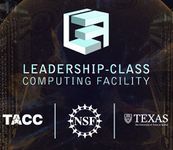
NSF LCCF Project
NSF Leadership Class Computing Facility is to support a computing system ten-fold or more time-to-solution performance improvement over Frontera, the current NSF leadership system. the LCCF Application Team Partners project is to continue the development of state-of-the-art earthquake modeling capabilities towards exascale, by porting and co-designing software on future LCCF systems for machine-specific performance efficiencies. More info
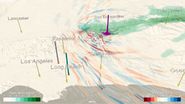
Intel oneAPI Center of Excellence
The Intel oneAPI CoE for Earthquake Simulation is an interdisciplinary research center with the goal of modernizing the highly scalable 3D earthquake modeling environment. The modernizations will feature cross-architecture programming to create portable, high-performance code for advanced high-performance computing systems. This project will continue our successful collaboration with Intel to get this state-of-the-art seismic wave propagation code updated to support multivendor and multiarchitecture systems for heterogeneous computing. More info

CyberShake SGT Calculation
AWP-ODC is a highly scalable, parallel finite-difference application developed at SDSC and SDSU to simulate dynamic rupture and wave propagation that occurs during an earthquake. We have developed strain Green's tensor (SGT) creation and seismogram synthesis. The GPU-based SGT calculations resulted in 6.5x speedup on XK7 compared to XE6, this improved computational efficency in the waveform modeling of CyberShake research will save hundreds of millions of processor-core hours to create a California state-wide physics-based seismic hazard map. More info
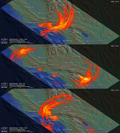
SCEC Data Visualization
This project focuses on the visualization of a series of large earthquake simulations in the interest of gaining scientific insight into the impact of Southern San Andreas Fault earthquake scenarios on Southern California. In addition to creating its own software, the group also uses tools installed and maintained on SDSC computational resources. More info
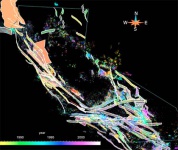
Simulating Earthquake Faults (FESD)
HPGeoC Researchers continue assisting researchers from several universities and the US Geological Survey (USGS) to develop detailed, large-scale computer simulations of earthquake faults. The initial focus is on the North American plate boundary and the San Andreas system of Northern and Southern California. More info
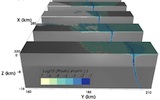
San Andreas Fault Zone Plasticity
Producing realistic seismograms at high frequencies will require several improvements in anelastic wave propagation engines, including the implementation of nonlinear material behavior. This project supports the development of nonlinear material behavior in both the CPU- and GPU-based wave propagation solvers. Simulations of the ShakeOut earthquake scenario have shown that nonlinearity could reduce the earlier predictions of long period (0 - 0.5 Hz) ground motions in the Los Angeles basin by 30-70. More info

Supercomputing On Demand: SDSC Supports Event-Driven Science
HPGeoC supports on-demand CalTech users for urgent science earthquake applications. National Science Foundation (NSF) XSEDE supercomputing resource Trestles is allocated to open this new computing paradigm. We've developed novel ways of utilizing this type of allocation as well as scheduling and job handling procedures. More info
Completed Projects

SCEC M8 Simulation
M8 is the largest earthquake simulation ever conducted, a collaborative effort led by SCEC and requiring collaboration of more than 30 seismologists and computational scientists, supported by DOE INCITE allocation award. It presented tremendous computational and I/O challenges. The simulation was conducted on NCCS Jaguar, a ACM Gordon Bell finalist at Supercomputing'10. More info
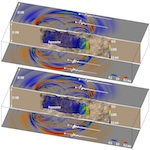
GPU Acceleration Project
HPGeoC has developed a hybrid CUDA MPI paradigm with AWP-ODC code that achieved 2.3 Pflop/s sustained performance and enabled a rough fault 0-10Hz modeling simulation on ORNL Titan. This code is also used to study the effects of nonlinearity on surface waves during large quakes on the San Andreas fault. More info
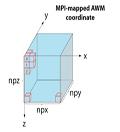
Topology-aware Communication and Scheduling (HECURA-2)
Topology-aware MPI communication, mapping, and scheduling is a new research area. This is to take advantage of the topological path to communication optimization  (either point-to-point or collective). We are participating in a joint project between OSU, TACC and SDSC as a case study in how to implement new topology-aware MPI software at the application level.

Petascale Inference in Earthquake System Science (PetaShake-2)
This is a SCEC project with cross-disciplinary, multi-institutional CME Collaboration. We are providing a platform-independent petascale earthquake application that is able to enlist petascale computing to tackle PetaShake problems through a graduated series of milestone calculations. More info
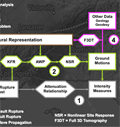
Petascale Cyberfacility for Physics-based Seismic Hazard Analysis (PetaSHA-3)
The SCEC PetaSHA-3 project is sponsored by NSF to provide society with better predictions of earthquake hazards. This project will provide the high- performance computing required to achieve the objectives for earthquake source physics and ground motion prediction outlined in the SCEC3 (2007-2012) research plan. More info

Blue Waters PAID
Supported by NSF Petascale Application Improvement Discovery (PAID) program through NCSA, this project will tune the SCEC community code AWP-ODC on Blue Waters for performance efficiency on Kepler. Our research will investigate how earthquake ruptures produce high frequency ground motions. High frequency ground motions are known to have an important impact on seismic hazards. Existing HPC systems cannot achieve the physical scale range needed to explore the source of high frequencies. More info
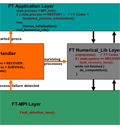
Fault Tolerance Project
Current checkpoint/restart approach may introduce an unacceptable amount of overhead into some file systems. In collaboration with CSM, we have developed a fault tolerance framework in which the survival application processes will adapt itself to failures. In collaborating with ORNL, we are integrating ADIOS to scale checkpointing up on Lustre file system. More info
Finished Projects
- PetaShake-1 Advanced computational platform designed to support high-resolution simulations of large earthquakes on initial NSF petascale machines, supported by NSF OCI and GEO grant
- HECURA-1 In collaboration with OSU and TACC, we developed non-blocking one-sided and two-sided communication and computation/communication overlap to improve the parallel efficiency of SCEC seismic applications.
- PetaSHA-1/2Cross-disciplinary, multi-institutional collaboration, coordinated by SCEC, each 2-year EAR/IF project with the same name to develop a cyberfacility with a common simulation framework for executing SHA computational pathways
- TeraShake The TeraShake Simulations model the rupture of a 230 kilometer stretch of the San Andreas fault and the consequent 7.7 magnitude earthquake. TeraShake wasa multi-institution collaboration led by SCEC/CME.
- Shakeout The Great California Shakeout is a statewide earthquake drill. It is held in October each year and serves as preparation for what to do before, during, and after an earthquake.
- Parallelization of Regional Spectral Method (RSM)